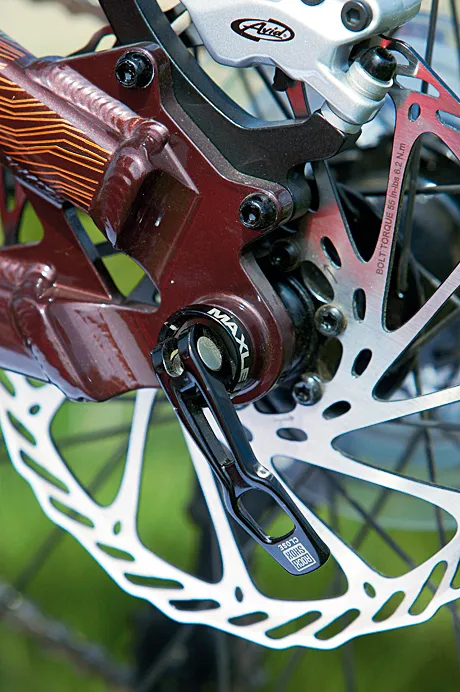Mongoose have drawn design input from whip-master general Steve Romaniuk to help put together the Boot’R. Their Freedrive suspension system is as much about being pedalled forwards as it is about moving up and down.
This makes for an interesting concept – big travel chassis and downhill race-worthy spec in a pedal-friendly platform. With such a great value pricetag, we just couldn’t resist finding out if this was as good as it looks.
The frame is built around a 210mm (8.3in) travel version of the Mongoose Freedrive system. Essentially, the rear swingarm is a high-mounted single-pivot design. What sets this design apart is that the bottom bracket is mounted to an independent link that swings from the front triangle, and is tethered to the rear triangle by an additional link.
By doing this, Mongoose have virtually eliminated the chain growth, suspension-induced pedal feedback and associated inefficiency normally found in high single-pivot designs.
The back end is nicely tied together with the excellent Maxle quick-release through-axle system and the 150mm axle spacing, keeping everything super stiff and showing it means business. An oversized top tube continues the burly theme, as does the 1.5in head tube.
The interrupted seat tube has an open end, increasing the amount of seatpost drop on tap, but care is needed to make sure the bottom of the post doesn’t hit the Fox Van R rear shock.
Considering the price, there’s some truly awesome kit on this bike. The RockShox 2010 Boxxer Race fork is a race-ready piece of kit. It only has minimal external adjustment, but has a super stiff chassis and a superbly well-controlled action.
Funn provide a quality direct-mount stem and a great shape bar with plenty of width. The top-end e.thirteen LG1+ chainguide is unheard of at this price, and SDG’s I-Beam saddle and post system is a good choice. Avid’s Elixir R brake levers are matched to their Code 5 four-pot callipers and sport a racy, downsized 180mm rear rotor and meaty 203mm front.
SRAM’s upgraded X.9 rear mech is another worthy upgrade, but the X.7 shifter should have had a separate clamp, as the Matchmaker clamp makes correct positioning impossible. The only real disappointments are the heavily-treaded Kenda Excavator DH tyres. They’re wet-weather friends, but sadly they’re too heavy and slow in dry conditions.
The Boot’R really doesn’t feel like a 210mm (8.6in) travel downhill bike when you swing a leg over and stomp on the cranks. Pedal power is transferred into forward motion in a way we’ve never experienced before in such a long travel platform. The problem is that it doesn’t feel like a 210mm travel bike once the going gets rough either.
A high pivot has a rearward axle path, and tethering the bottom bracket axle to the swingarm gives your pedals a rearward path as the suspension compresses too. Hit a decent impact and this is instantly noticeable as the sudden yank at the bottom bracket tries to pull the pedals away from your feet.
The movement of this important point of contact makes the bike very difficult to predict and control, because the distance between the bars and pedals is constantly changing. It was incredibly hard to carry speed through rock gardens too. We naturally drop our heels to tackle these sections, which meant our bodyweight was actually resisting the suspension travel, slowing the bike and giving our ankles a proper pummelling.
On the plus side, the bottom bracket movement was much less of a problem on slower, single impacts, such as landing from jumps and drops. The RockShox Boxxer fork is a great performer once through the four- to six-hour break-in period, and totally out performs the rear end of the Boot’R. The tall and chunky tread of the Kenda tyres isn’t very well supported, and you can feel them flexing as you corner hard and initiating a slide all too early.
Mongoose have done a good job of creating a bike that pedals so well with so much travel. Unfortunately, that’s at the cost of DH performance, which is surely the point of having 210mm (8.3in) of travel? The Freedrive system may work for shorter travel, less focussed machines, but it’s just not the one for a downhill bike.





